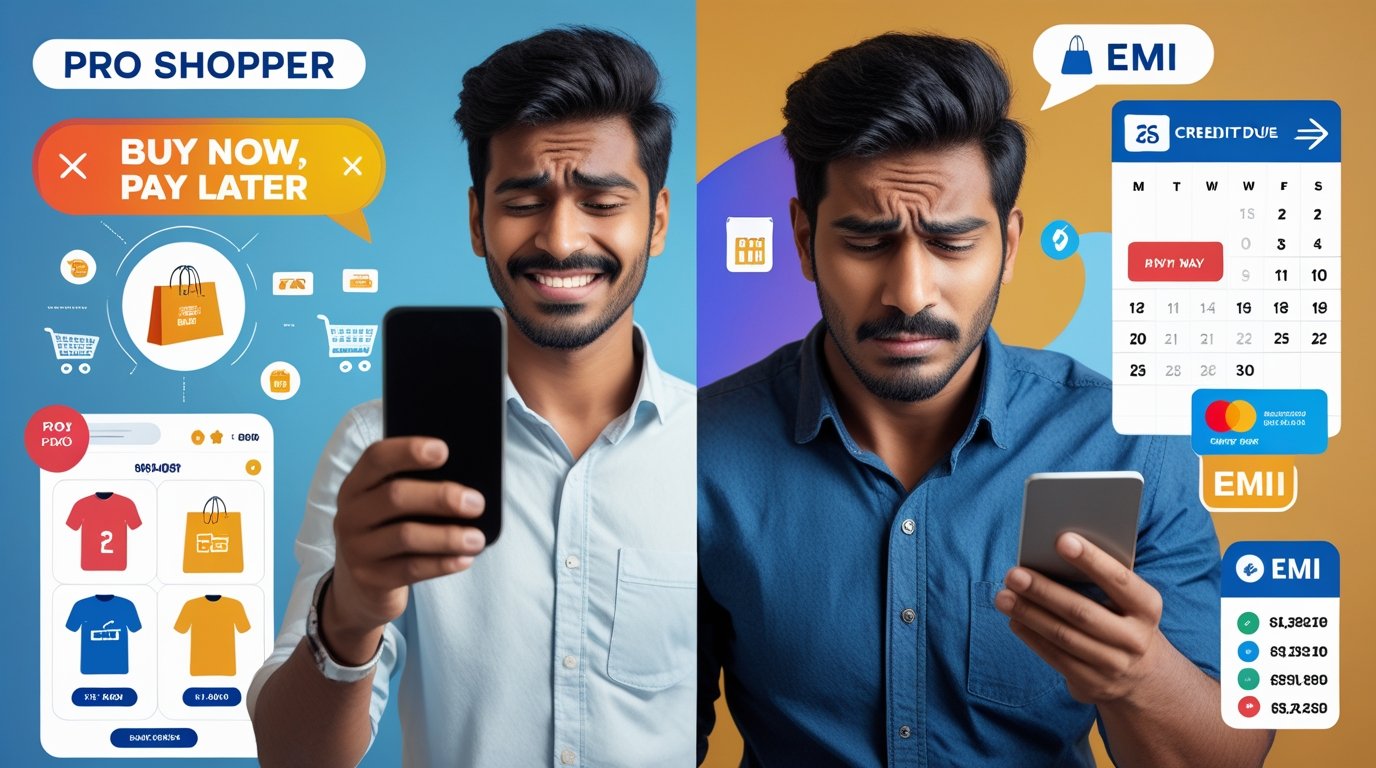Ever been tempted to snag that new gadget or outfit with a “pay later” option at checkout? Buy Now, Pay Later (BNPL) services like Afterpay, Klarna, and Affirm have exploded in popularity, with global BNPL transactions reaching $350 billion in 2024, per Statista. These services let you split purchases into installments, often interest-free, making shopping feel effortless. But are they a financial game-changer or a debt trap? In 2025’s unpredictable economy, understanding the pros and cons of Buy Now, Pay Later is crucial. This article dives into the benefits, risks, and practical tips to use BNPL wisely, backed by real-world examples and expert insights.
What Are Buy Now, Pay Later Services?
Buy Now, Pay Later allows consumers to purchase goods and pay in installments, typically over weeks or months, without traditional credit cards. Common providers include Affirm, Afterpay, and PayPal’s Pay in 4. Payments are often split into four equal parts, due biweekly, with no interest if paid on time.
How BNPL Works
- Checkout: Select BNPL at participating retailers (e.g., Amazon, Target).
- Approval: Providers assess eligibility via soft credit checks, not impacting your score.
- Payment Plan: Pay 25% upfront, with three more installments over 6 weeks.
- Fees: Late payments incur fees ($7–$10) or interest (up to 30% APR).
The BNPL Boom in 2025
- Market Growth: BNPL adoption rose 40% from 2020–2024, per McKinsey.
- Young Users: 60% of Gen Z used BNPL in 2024, per a Visa study.
- New Features: AI-driven BNPL apps now offer personalized payment plans and spending alerts.
Pros of Buy Now, Pay Later Services
BNPL offers compelling benefits, making it a go-to for many shoppers.
1. Interest-Free Payments
Unlike credit cards (average 20% APR in 2024), most BNPL plans are 0% interest if paid on time.
- Example: A $400 laptop split into four $100 payments over 6 weeks costs $400 total with Afterpay.
- Savings: Avoids hundreds in interest compared to credit card debt.
2. Flexible Budgeting
BNPL spreads costs, easing the strain on your budget.
- Case Study: Mia, a 25-year-old teacher, used Klarna to buy a $200 dress for a wedding, paying $50/month over 4 months without disrupting her rent or bills.
- Benefit: Aligns purchases with paychecks, ideal for irregular incomes.
3. Easy Approval
BNPL providers use soft credit checks, approving users with limited or poor credit.
- Accessibility: 70% of BNPL users have credit scores below 700, per 2024 Experian data.
- No Hard Inquiries: Preserves your credit score for loans or mortgages.
4. Encourages Responsible Spending
Short-term plans (6–12 weeks) deter overspending compared to credit cards’ revolving debt.
- Behavioral Shift: Users plan purchases, knowing payments are due soon.
- Transparency: Clear schedules outline total costs upfront.
Cons of Buy Now, Pay Later Services
Despite its perks, BNPL has risks that can derail finances.
1. Risk of Overspending
Easy access tempts users to buy beyond their means.
- Stat: 43% of BNPL users spent more than planned, per a 2024 CFPB report.
- Example: Jake, a freelancer, racked up $1,200 in BNPL plans, missing payments when a client delayed payment.
2. Late Fees and Interest
Missing payments triggers penalties or high interest.
- Fees: Afterpay charges $8 per late payment, capped at 25% of the purchase.
- Interest: Affirm’s longer plans can hit 30% APR, rivaling credit cards.
- Impact: Late payments may be reported to credit bureaus, hurting scores.
3. Debt Accumulation
Juggling multiple BNPL plans can mimic credit card debt.
- Data: 20% of users had 3+ active BNPL plans in 2024, per TransUnion.
- Risk: Overlapping payments strain budgets, leading to missed bills or reliance on other credit.
4. Limited Consumer Protections
BNPL lacks the robust safeguards of credit cards.
- Returns/Disputes: Refunds depend on retailers, not BNPL providers, complicating issues.
- Regulation: BNPL is less regulated than loans, with fewer dispute resolution options.
What’s New in 2025: BNPL Trends
- AI Personalization: Klarna’s AI suggests payment plans based on spending habits, used by 50% of its users in 2024.
- Credit Reporting: Affirm and Afterpay now report on-time payments to Experian, boosting credit for 30% of users.
- BNPL for Essentials: Groceries and utilities now accept BNPL via apps like Zip, reflecting rising costs.
- Embedded Finance: Retailers like Walmart integrate BNPL directly, streamlining checkout.
Pros and Cons Comparison Table
| Aspect | Pros | Cons |
|---|---|---|
| Cost | 0% interest if paid on time. | Late fees ($7–$10) or high interest (30% APR). |
| Accessibility | Easy approval, no hard credit checks. | Tempts overspending, especially for low-income users. |
| Budgeting | Spreads payments, aligns with paychecks. | Multiple plans lead to debt accumulation. |
| Consumer Protections | Transparent payment schedules. | Limited refund/dispute options vs. credit cards. |
Tips for Using BNPL Wisely
- Budget First: Only use BNPL for planned purchases within your means.
- Track Plans: Use apps like Rocket Money to monitor multiple BNPL schedules.
- Pay Early: Clear installments ahead of time to avoid fees.
- Read Terms: Check for hidden fees or interest, especially with longer plans.
- Limit Plans: Stick to one active BNPL plan to prevent overlap.
Case Study: Sarah, a retail worker, used Afterpay for a $300 couch, paying $75 biweekly. By budgeting and paying early, she avoided fees and kept her finances intact.
FAQ Section
What Are Buy Now, Pay Later Services?
Buy Now, Pay Later (BNPL) services let you split purchases into installments, often interest-free, over weeks or months. Providers like Afterpay or Klarna offer four biweekly payments (e.g., $100 for a $400 item). Approval uses soft credit checks, preserving your score. BNPL is great for budgeting but risks overspending or late fees ($7–$10). Always review terms and limit plans.
What Are the Benefits of Using BNPL?
BNPL offers 0% interest plans, flexible budgeting, and easy approval. For example, a $200 purchase via Klarna costs $50/month over 4 months, saving $20–$40 in credit card interest. It’s accessible for low-credit users (70% have scores below 700). Short-term plans encourage discipline. Use BNPL for planned purchases and track payments with apps like Mint to maximize benefits.
What Are the Risks of BNPL Services?
Risks include overspending (43% of users exceed budgets), late fees ($8 per missed payment), and debt accumulation from multiple plans (20% juggle 3+). High-interest plans (up to 30% APR) mimic credit card debt. BNPL lacks credit card protections for disputes. Budget carefully, limit to one plan, and pay early to avoid pitfalls, per CFPB advice.
How Can I Use BNPL Safely in 2025?
Budget before using Buy Now, Pay Later and only buy what you can afford. Use one plan at a time to avoid overlap. Track payments with Rocket Money and pay early to dodge $7–$10 late fees. Read terms for interest (e.g., Affirm’s 30% APR). Check if providers report payments to build credit. Compare options on NerdWallet.com.
Are BNPL Services Better Than Credit Cards?
BNPL offers 0% interest and easier approval than credit cards (20% APR average). However, credit cards provide rewards, better dispute protections, and longer repayment flexibility. BNPL risks late fees and debt if mismanaged. For small, planned purchases, BNPL is cheaper; for ongoing or large expenses, credit cards may be safer. Assess your needs and discipline.
Conclusion
Buy Now, Pay Later services offer a convenient way to manage purchases, with interest-free payments and easy approval making them a hit in 2025. However, risks like overspending, late fees, and debt accumulation demand caution. By budgeting, limiting plans, and using tools like AI-driven payment trackers, you can harness BNPL’s benefits while avoiding pitfalls. Weigh the pros and cons of Buy Now, Pay Later to make informed choices. Share your BNPL experiences in the comments or join our newsletter for more financial tips!
Suggested Internal Links
Suggested External Links
Suggested Visuals
- Infographic comparing BNPL vs. credit cards.
- Video explainer on using Afterpay safely.

